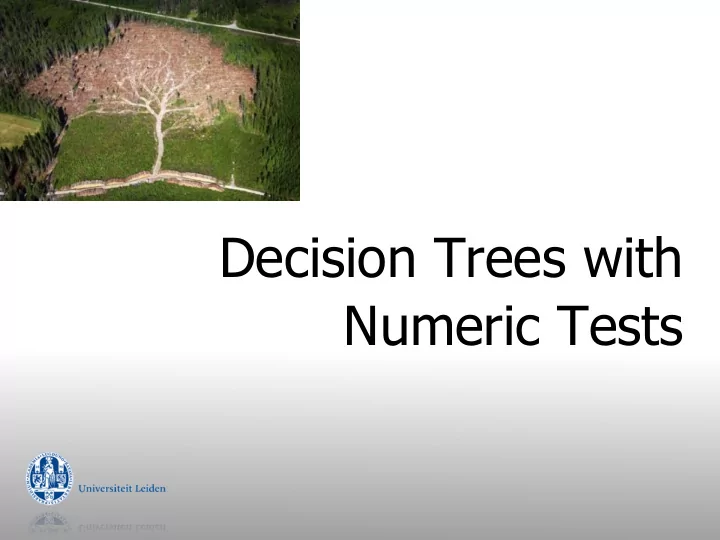

Decision Trees with Numeric Tests
Industrial-strength algorithms For an algorithm to be useful in a wide range of real- § world applications it must: Permit numeric attributes § Allow missing values § Be robust in the presence of noise § Basic schemes need to be extended to fulfill these § requirements
C4.5 History § ID3, CHAID – 1960s § C4.5 innovations (Quinlan): § permit numeric attributes § deal sensibly with missing values § pruning to deal with for noisy data § C4.5 - one of best-known and most widely-used learning algorithms § Last research version: C4.8, implemented in Weka as J4.8 (Java) § Commercial successor: C5.0 (available from Rulequest)
Numeric attributes Standard method: binary splits § E.g. temp < 45 § Unlike nominal attributes, § every attribute has many possible split points Solution is straightforward extension: § Evaluate info gain (or other measure) § for every possible split point of attribute Choose “ best ” split point § Info gain for best split point is info gain for attribute § Computationally more demanding §
Example Split on temperature attribute: § 64 65 68 69 70 71 72 72 75 75 80 81 83 85 Yes No Yes Yes Yes No No Yes Yes Yes No Yes Yes No E.g. temperature < 71.5: yes/4, no/2 § temperature ≥ 71.5: yes/5, no/3 Info([4,2],[5,3]) § = 6/14 info([4,2]) + 8/14 info([5,3]) = 0.939 bits Place split points halfway between values § Can evaluate all split points in one pass! §
Example Split on temperature attribute: § 64 65 68 69 70 71 72 72 75 75 80 81 83 85 Yes No Yes Yes Yes No No Yes Yes Yes No Yes Yes No infoGain 0
Speeding up § Entropy only needs to be evaluated between points of different classes (Fayyad & Irani, 1992) value 64 65 68 69 70 71 72 72 75 75 80 81 83 85 X class Yes No Yes Yes Yes No No Yes Yes Yes No Yes Yes No Potential optimal breakpoints Breakpoints between values of the same class cannot be optimal
Application: Computer Vision 1
Application: Computer Vision 2 feature extraction § color (RGB, hue, saturation) § edge, orientation § texture § XY coordinates § 3D information
Application: Computer Vision 3 how grey? below horizon?
Application: Computer Vision 4 prediction
Application: Computer Vision 4 inverse perspective
Application: Computer Vision 5 inverse perspective path planning
Quiz 1 Q: If an attribute A has high info gain, does it always appear in a decision tree? A: No. If it is highly correlated with another attribute B, and infoGain(B) > infoGain(A), then B will appear in the tree, and further splitting on A will not be useful. B + + + + + - - - - A
Quiz 2 Q: Can an attribute appear more than once in a decision tree? A: Yes. If a test is not at the root of the tree, it can appear in different branches. Q: And on a single path in the tree (from root to leaf)? A: Yes. Numeric attributes can appear more than once, but only with very different numeric conditions. + + + - - - + + - A
Quiz 3 Q: If an attribute A has infoGain(A)=0, can it ever appear in a decision tree? A: Yes. 1. All attributes may have zero info gain. 2. info gain often changes when splitting on another attribute. B - + + + - - + - + - - + the XOR problem: + - - + A
Recommend
More recommend